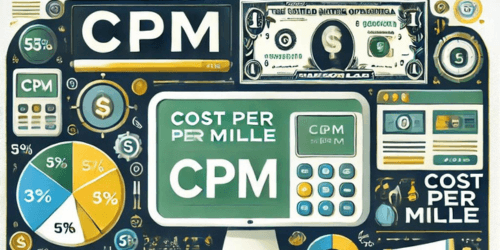
Cost Per Mille (CPM), also known as Cost Per Thousand, is a metric used in digital advertising that refers to the cost advertisers pay for every 1,000 impressions their ads receive. It’s one of the most widely used pricing models in display and video ads, particularly in brand awareness campaigns.
How CPM is Calculated
CPM is determined by dividing the total advertising cost by the number of impressions and multiplying by 1,000:
CPM Formula:
CPM = (Total Cost ÷ Impressions) × 1000
For example, if a campaign costs $500 and generates 100,000 impressions, the CPM would be $5.
Why CPM Matters in Advertising
CPM is especially valuable for businesses focused on raising awareness rather than driving immediate conversions. It’s cost-efficient for reaching large audiences, making it suitable for advertisers who want to increase visibility without necessarily needing users to click through immediately.
CPM pricing is common across platforms like Facebook, Google Ads, and YouTube, where advertisers aim to build brand recognition and reach new audiences at a relatively low cost. It provides a clear picture of how far the budget will go in terms of exposure.
When to Use CPM
CPM works best in campaigns focused on:
- Brand Awareness: If the goal is to get a message in front of as many eyes as possible, CPM is ideal.
- Display Ads: Banner ads and video ads benefit from CPM, as they appear on content users already engage with, making impressions a meaningful metric.
- Broad Targeting: For companies looking to create awareness on a large scale without targeting specific actions like clicks or conversions, CPM is often more effective than Cost Per Click (CPC) or Cost Per Action (CPA) models.
CPM vs. Other Pricing Models
- CPM vs. CPC: With Cost Per Click (CPC), advertisers only pay when users click on the ad, which is more action-focused. In contrast, CPM charges for impressions, not interactions, which is ideal for awareness rather than immediate user engagement.
- CPM vs. CPA: Cost Per Action (CPA) requires advertisers to pay when users complete a specific action, such as a purchase or sign-up. CPM works higher up the marketing funnel, focusing on exposure and reach, while CPA is useful later for driving conversions.
How to Maximize CPM Campaigns
- Target the Right Audience: Fine-tuning targeting parameters ensures ads appear to users who are more likely to be interested, maximizing the value of each impression.
- Optimize Ad Placements: Choosing premium placements or well-designed ad creatives can significantly improve visibility and engagement, thus enhancing the effectiveness of CPM campaigns.
- Monitor CPM Anomalies: A sudden spike in CPM may indicate overly narrow targeting or inefficient ad placements, signaling that adjustments may be needed.